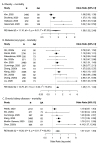Risk factors for poor outcomes in hospitalised COVID-19 patients: A systematic review and meta-analysis
- PMID: 33767855
- PMCID: PMC7980087
- DOI: 10.7189/jogh.11.10001
Risk factors for poor outcomes in hospitalised COVID-19 patients: A systematic review and meta-analysis
Abstract
Background: Understanding the risk factors for poor outcomes among COVID-19 patients could help identify vulnerable populations who would need prioritisation in prevention and treatment for COVID-19. We aimed to critically appraise and synthesise published evidence on the risk factors for poor outcomes in hospitalised COVID-19 patients.
Methods: We searched PubMed, medRxiv and the WHO COVID-19 literature database for studies that reported characteristics of COVID-19 patients who required hospitalisation. We included studies published between January and May 2020 that reported adjusted effect size of any demographic and/or clinical factors for any of the three poor outcomes: mortality, intensive care unit (ICU) admission, and invasive mechanical ventilation. We appraised the quality of the included studies using Joanna Briggs Institute appraisal tools and quantitatively synthesised the evidence through a series of random-effect meta-analyses. To aid data interpretation, we further developed an interpretation framework that indicated strength of the evidence, informed by both quantity and quality of the evidence.
Results: We included a total of 40 studies in our review. Most of the included studies (29/40, 73%) were assessed as "good quality", with assessment scores of 80 or more. We found that male sex (pooled odds ratio (OR) = 1.32 (95% confidence interval (CI) = 1.18-1.48; 20 studies), older age (OR = 1.05, 95% CI = 1.04-1.07, per one year of age increase; 10 studies), obesity (OR = 1.59, 95% CI = 1.02-2.48; 4 studies), diabetes (OR = 1.25, 95% CI = 1.11-1.40; 11 studies) and chronic kidney diseases (6 studies; OR = 1.57, 95% CI = 1.27-1.93) were associated with increased risks for mortality with the greatest strength of evidence based on our interpretation framework. We did not find increased risk of mortality for several factors including chronic obstructive pulmonary diseases (5 studies), cancer (4 studies), or current smoker (5 studies); however, this does not indicate absence of risk due to limited data on each of these factors.
Conclusion: Male sex, older age, obesity, diabetes and chronic kidney diseases are important risk factors of COVID-19 poor outcomes. Our review provides not only an appraisal and synthesis of evidence on the risk factors of COVID-19 poor outcomes, but also a data interpretation framework that could be adopted by relevant future research.
Copyright © 2021 by the Journal of Global Health. All rights reserved.
Conflict of interest statement
Competing interests: YL reports grants from WHO, outside the submitted work. HN reports grants from the Innovative Medicines Initiative, WHO, and the National Institute for Health Research; personal fees from the Bill & Melinda Gates Foundation, Janssen, and AbbVie; and grants and personal fees from Sanofi and the Foundation for Influenza Epidemiology, outside the submitted work. The authors have completed the ICMJE competing interests form (available upon request from the corresponding author), and declare no further conflicts of interest.
Figures







References
Publication types
MeSH terms
Grants and funding
LinkOut - more resources
Full Text Sources
Other Literature Sources
Medical
